Au Clusters Supported on Defect-Rich Ni-Ti Oxides Derived from Ultrafine Layered Double Hydroxides (LDHs) for CO Oxidation at Ambient Temperature
Abstract
1. Introduction
2. Results and Discussion
2.1. Characterization of Ni-Ti LDH/SiO2
2.2. Characterization of Ni-Ti MMO/SiO2
2.3. Characterization of Au/Ni-Ti MMO/SiO2
2.4. Catalytic Activity for CO Oxidation
2.5. Evaluation of Oxygen Vacancies on Ni-Ti MMO/SiO2
2.6. Temperature-Programmed Reaction of CO
2.7. CO Oxidation in Humid Air
3. Materials and Methods
3.1. Catalyst Preparation
3.1.1. Materials
3.1.2. Ni-Ti LDH/SiO2
3.1.3. Au/Ni-Ti MMO/SiO2 (LDH-DP and MMO-DP)
3.1.4. Au/Ni-Ti MMO/SiO2 (LDH-DPU and MMO-DPU)
3.1.5. Au/bulk Ni-Ti MMO
3.2. Characterization
3.3. CO Oxidation
4. Conclusions
Supplementary Materials
Author Contributions
Funding
Data Availability Statement
Acknowledgments
Conflicts of Interest
References
- Haruta, M.; Kobayashi, T.; Sano, H.; Yamada, N. Novel Gold Catalysts for the Oxidation of Carbon Monoxide at a Temperature Far Below 0 °C. Chem. Lett. 1987, 16, 405–408. [Google Scholar] [CrossRef]
- Ishida, T.; Murayama, T.; Taketoshi, A.; Haruta, M. Importance of Size and Contact Structure of Gold Nanoparticles for the Genesis of Unique Catalytic Processes. Chem. Rev. 2019, 120, 464–525. [Google Scholar] [CrossRef] [PubMed]
- Okumura, M.; Fujitani, T.; Huang, J.; Ishida, T. A Career in Catalysis: Masatake Haruta. ACS Catal. 2015, 5, 4699–4707. [Google Scholar] [CrossRef]
- Ishida, T.; Koga, H.; Okumura, M.; Haruta, M. Advances in Gold Catalysis and Understanding the Catalytic Mechanism. Chem. Rec. 2016, 16, 2278–2293. [Google Scholar] [CrossRef] [PubMed]
- Min, B.K.; Friend, C.M. Heterogeneous Gold-Based Catalysis for Green Chemistry: Low-Temperature CO Oxidation and Propene Oxidation. Chem. Rev. 2007, 107, 2709–2724. [Google Scholar] [CrossRef]
- Fujitani, T.; Nakamura, I. Mechanism and Active Sites of the Oxidation of CO over Au/TiO2. Angew. Chem. Int. Ed. 2011, 50, 10144–10147. [Google Scholar] [CrossRef]
- Widmann, D.; Behm, R.J. Activation of Molecular Oxygen and the Nature of the Active Oxygen Species for Co Oxidation on Oxide Supported Au Catalysts. Acc. Chem. Res. 2014, 47, 740–749. [Google Scholar] [CrossRef]
- Schlexer, P.; Widmann, D.; Behm, R.J.; Pacchioni, G. CO Oxidation on a Au/TiO2 Nanoparticle Catalyst via the Au-Assisted Mars–van Krevelen Mechanism. ACS Catal. 2018, 8, 6513–6525. [Google Scholar] [CrossRef]
- Qiao, B.; Liang, J.X.; Wang, A.; Liu, J.; Zhang, T. Single Atom Gold Catalysts for Low-Temperature CO Oxidation. Chin. J. Catal. 2016, 37, 1580–1586. [Google Scholar] [CrossRef]
- Qiao, B.; Liu, J.; Wang, Y.G.; Lin, Q.; Liu, X.; Wang, A.; Li, J.; Zhang, T.; Liu, J. Highly Efficient Catalysis of Preferential Oxidation of CO in H2-Rich Stream by Gold Single-Atom Catalysts. ACS Catal. 2015, 5, 6249–6254. [Google Scholar] [CrossRef]
- Qiao, B.; Lin, J.; Wang, A.; Chen, Y.; Zhang, T.; Liu, J. Highly Active Au1/Co3O4 Single-Atom Catalyst for CO Oxidation at Room Temperature. Chin. J. Catal. 2015, 36, 1505–1511. [Google Scholar] [CrossRef]
- Qiao, B.; Liang, J.X.; Wang, A.; Xu, C.Q.; Li, J.; Zhang, T.; Liu, J.J. Ultrastable Single-Atom Gold Catalysts with Strong Covalent Metal-Support Interaction (CMSI). Nano Res. 2015, 8, 2913–2924. [Google Scholar] [CrossRef]
- Mochizuki, C.; Inomata, Y.; Yasumura, S.; Lin, M.; Taketoshi, A.; Honma, T.; Sakaguchi, N.; Haruta, M.; Shimizu, K.; Ishida, T.; et al. Defective NiO as a Stabilizer for Au Single-Atom Catalysts. ACS Catal. 2022, 12, 6149–6158. [Google Scholar] [CrossRef]
- Pennington, A.M.; Pitman, C.L.; Desario, P.A.; Brintlinger, T.H.; Jeon, S.; Balow, R.B.; Pietron, J.J.; Stroud, R.M.; Rolison, D.R. Photocatalytic CO Oxidation over Nanoparticulate Au-Modifi Ed TiO2 Aerogels: The Importance of Size and Intimacy. ACS Catal. 2020, 10, 14834–14846. [Google Scholar] [CrossRef]
- Dien, L.X.; Ishida, T.; Taketoshi, A.; Truong, D.Q.; Dang Chinh, H.; Honma, T.; Murayama, T.; Haruta, M. Supported Gold Cluster Catalysts Prepared by Solid Grinding Using a Non-Volatile Organogold Complex for Low-Temperature CO Oxidation and the Effect of Potassium on Gold Particle Size. Appl. Catal. B Environ. 2019, 241, 539–547. [Google Scholar] [CrossRef]
- Daté, M.; Okumura, M.; Tsubota, S.; Haruta, M. Vital Role of Moisture in the Catalytic Activity of Supported Gold Nanoparticles. Angew. Chem. Int. Ed. 2004, 43, 2129–2132. [Google Scholar] [CrossRef] [PubMed]
- Saavedra, J.; Pursell, C.J.; Chandler, B.D. CO Oxidation Kinetics over Au/TiO2 and Au/Al2O3 Catalysts: Evidence for a Common Water-Assisted Mechanism. J. Am. Chem. Soc. 2018, 140, 3712–3723. [Google Scholar] [CrossRef]
- Xu, M.; Wei, M. Layered Double Hydroxide-Based Catalysts: Recent Advances in Preparation, Structure, and Applications. Adv. Funct. Mater. 2018, 28, 1802943. [Google Scholar] [CrossRef]
- Zhang, F.; Zhao, X.; Feng, C.; Li, B.; Chen, T.; Lu, W.; Lei, X.; Xu, S. Crystal-Face-Selective Supporting of Gold Nanoparticles on Layered Double Hydroxide as Efficient Catalyst for Epoxidation of Styrene. ACS Catal. 2011, 1, 232–237. [Google Scholar] [CrossRef]
- Zhao, Y.; Li, B.; Wang, Q.; Gao, W.; Wang, C.J.; Wei, M.; Evans, D.G.; Duan, X.; O’Hare, D. NiTi-Layered Double Hydroxides Nanosheets as Efficient Photocatalysts for Oxygen Evolution from Water Using Visible Light. Chem. Sci. 2014, 5, 951–958. [Google Scholar] [CrossRef]
- Zhao, Y.; Jia, X.; Chen, G.; Shang, L.; Waterhouse, I.N.; Wu, L.; Tung, C.; Hare, D.O.; Zhang, T. Ultrafine NiO Nanosheets Stabilized by TiO2 from Monolayer NiTi-LDH Precursors: An Active Water Oxidation Electrocatalyst. J. Am. Chem. Soc. 2016, 138, 6517–6524. [Google Scholar] [CrossRef] [PubMed]
- Zhao, Y.; Chen, G.; Bian, T.; Zhou, C.; Waterhouse, G.I.N.; Wu, L.; Tung, C.; Smith, L.J.; Hare, D.O.; Zhang, T. Defect-Rich Ultrathin ZnAl-Layered Double Hydroxide Nanosheets for Efficient Photoreduction of CO2 to CO with Water. Adv. Mater. 2015, 27, 7824–7831. [Google Scholar] [CrossRef] [PubMed]
- Ge, X.; Gu, C.; Yin, Z.; Wang, X.; Tu, J.; Li, J. Periodic Stacking of 2D Charged Sheets: Self-Assembled Superlattice of Ni–Al Layered Double Hydroxide (LDH) and Reduced Graphene Oxide. Nano Energy 2016, 20, 185–193. [Google Scholar] [CrossRef]
- Wang, H.; Fan, G.; Zheng, C.; Xiang, X.; Li, F. Facile Sodium Alginate Assisted Assembly of Ni-Al Layered Double Hydroxide Nanostructures. Ind. Eng. Chem. Res. 2010, 49, 2759–2767. [Google Scholar] [CrossRef]
- Cells, D.S.; Qu, Y.; Zhou, W.; Miao, X.; Li, Y.; Jiang, L.; Pan, K. A New Layered Photocathode with Porous NiO Nanosheets: An Effective Candidate for p-Type Dye-Sensitized Solar Cells. Chem. Asian J. 2013, 8, 3085–3090. [Google Scholar] [CrossRef]
- Rathee, G.; Kohli, S.; Panchal, S.; Singh, N.; Awasthi, A.; Singh, S.; Singh, A.; Hooda, S.; Chandra, R. Fabrication of a Gold-Supported NiAlTi-Layered Double Hydroxide Nanocatalyst for Organic Transformations. ACS Omega 2020, 5, 23967–23974. [Google Scholar] [CrossRef]
- Wang, L.; Zhang, J.; Zhu, Y.; Xu, S.; Wang, C.; Bian, C.; Meng, X.; Xiao, F.S. Strong Metal-Support Interactions Achieved by Hydroxide-to-Oxide Support Transformation for Preparation of Sinter-Resistant Gold Nanoparticle Catalysts. ACS Catal. 2017, 7, 7461–7465. [Google Scholar] [CrossRef]
- Xu, X.; Fu, Q.; Guo, X.; Bao, X. A Highly Active “NiO-on-Au” Surface Architecture for CO Oxidation. ACS Catal. 2013, 3, 1810–1818. [Google Scholar] [CrossRef]
- Carabineiro, S.A.C.; Bogdanchikova, N.; Avalos-borja, M.; Pestryakov, A.; Tavares, P.B.; Figueiredo, J.L. Gold Supported on Metal Oxides for Carbon Monoxide Oxidation. Nano Res. 2011, 4, 180–193. [Google Scholar] [CrossRef]
- Li, X.; Patil, K.; Agarwal, A.; Babar, P.; Jang, J.S.; Chen, X.; Yoo, Y.T.; Kim, J.H. Ni(OH)2 Coated CoMn-Layered Double Hydroxide Nanowires as Efficient Water Oxidation Electrocatalysts. New J. Chem. 2022, 46, 2044–2052. [Google Scholar] [CrossRef]
- Xu, J.; Tang, M.; Hu, Z.; Hu, X.; Zhou, T.; Song, K.; Wu, J.; Cheng, J. Standing and Lying Ni(OH)2 Nanosheets on Multilayer Graphene for High-Performance Supercapacitors. Nanomaterials 2021, 11, 1662. [Google Scholar] [CrossRef]
- Liu, G.; Ouyang, X.; Wei, X.; Bao, W.; Feng, X.; Zhang, J. Coupling Interface Construction of Ni(OH)2/MoS2 Composite Electrode for Efficient Alkaline Oxygen Evolution Reaction. Catalysts 2022, 12, 966. [Google Scholar] [CrossRef]
- Liu, A.; Liu, G.; Zhu, H.; Shin, B.; Fortunato, E. Hole Mobility Modulation of Solution-Processed Nickel Oxide Thin-Film Transistor Based on High-k Dielectric. Appl. Phys. Lett. 2016, 108, 233506. [Google Scholar] [CrossRef]
- Chen, Y.S.; Kang, J.F.; Chen, B.; Gao, B.; Liu, L.F.; Liu, X.Y.; Wang, Y.Y.; Wu, L.; Yu, H.Y.; Wang, J.Y.; et al. Microscopic Mechanism for Unipolar Resistive Switching Behaviour of Nickel Oxides. J. Phys. D Appl. Phys. 2012, 45, 065303. [Google Scholar] [CrossRef]
- Shih, Y.; Huang, Y.; Huang, C.P. Electrocatalytic Ammonia Oxidation over a Nickel Foam Electrode: Role of Ni(OH)2(s)-NiOOH(s) Nanocatalysts. Electrochim. Acta 2018, 263, 261–271. [Google Scholar] [CrossRef]
- Wang, Z.; Lin, R.; Huo, Y.; Li, H.; Wang, L. Formation, Detection, and Function of Oxygen Vacancy in Metal Oxides for Solar Energy Conversion. Adv. Funct. Mater. 2022, 32, 2109503. [Google Scholar] [CrossRef]
- Ali, H.; Vandevyvere, T.; Lauwaert, J.; Kumar, S.; Saravanamurugan, S.; Thybaut, J.W. Impact of Oxygen Vacancies in Ni Supported Mixed Oxide Catalysts on Anisole Hydrodeoxygenation. Catal. Commun. 2022, 164, 106436. [Google Scholar] [CrossRef]
- Wang, S.; Cai, J.; Mao, J.; Li, S.; Shen, J.; Gao, S. Defective Black Ti3+ Self-Doped TiO2 and Reduced Graphene Oxide Composite Nanoparticles for Boosting Visible-Light Driven Photocatalytic and Photoelectrochemical Activity. Appl. Surf. Sci. 2019, 467–468, 45–55. [Google Scholar] [CrossRef]
- Nawaz, R.; Kait, C.F.; Chia, H.Y.; Isa, M.H.; Huei, L.W.; Sahrin, N.T. Synthesis of Black-TiO2 and Manganese-Doped TiO2 Nanoparticles and Their Comparative Performance Evaluation for Photocatalytic Removal of Phenolic Compounds from Agro-Industrial Effluent. J. Nanopart. Res. 2021, 23, 263. [Google Scholar] [CrossRef]
- Fujita, T.; Ishida, T.; Shibamoto, K.; Honma, T.; Ohashi, H.; Murayama, T.; Haruta, M. CO Oxidation over Au/ZnO: Unprecedented Change of the Reaction Mechanism at Low Temperature Caused by a Different O2 Activation Process. ACS Catal. 2019, 9, 8364–8372. [Google Scholar] [CrossRef]
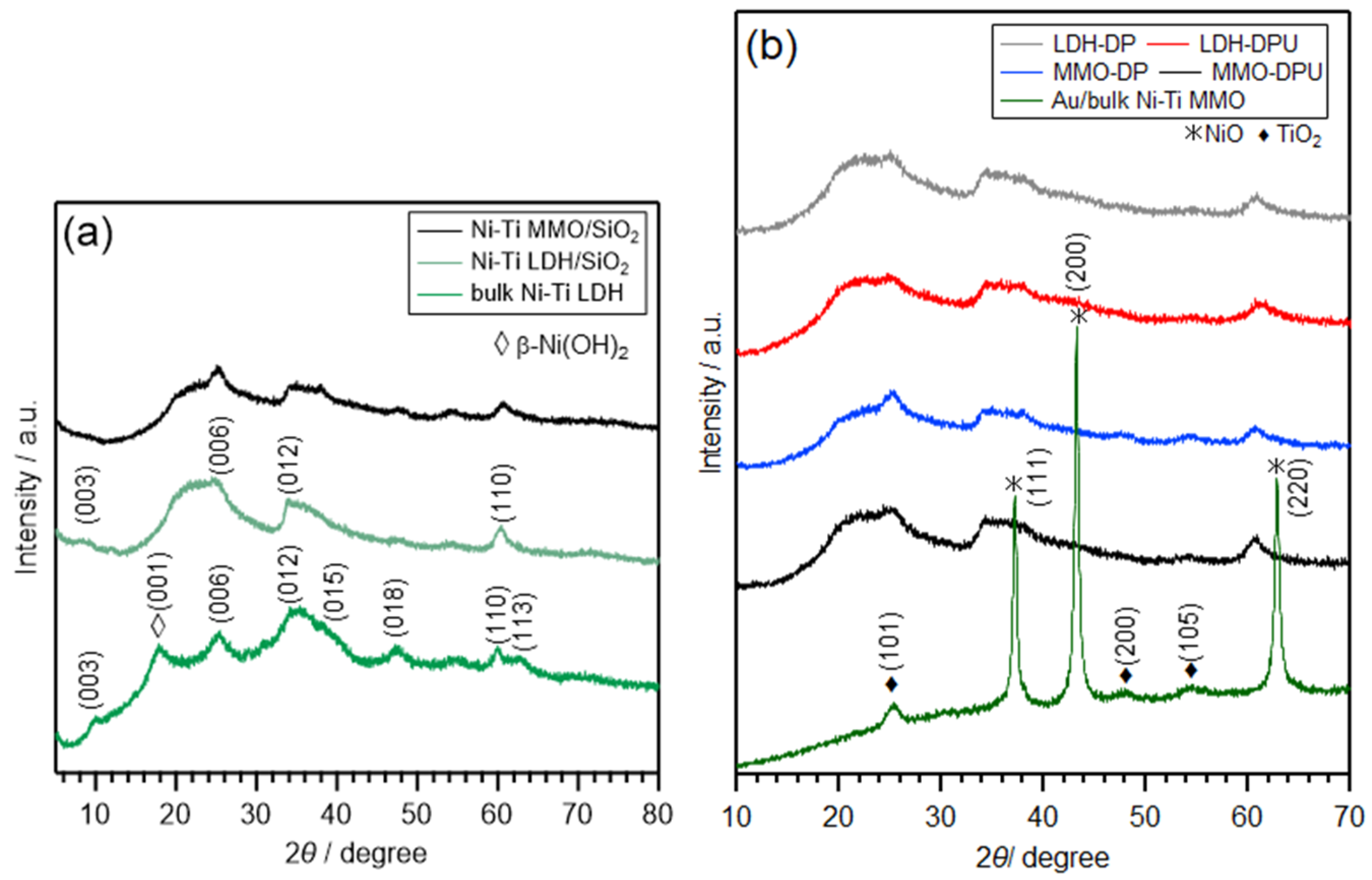

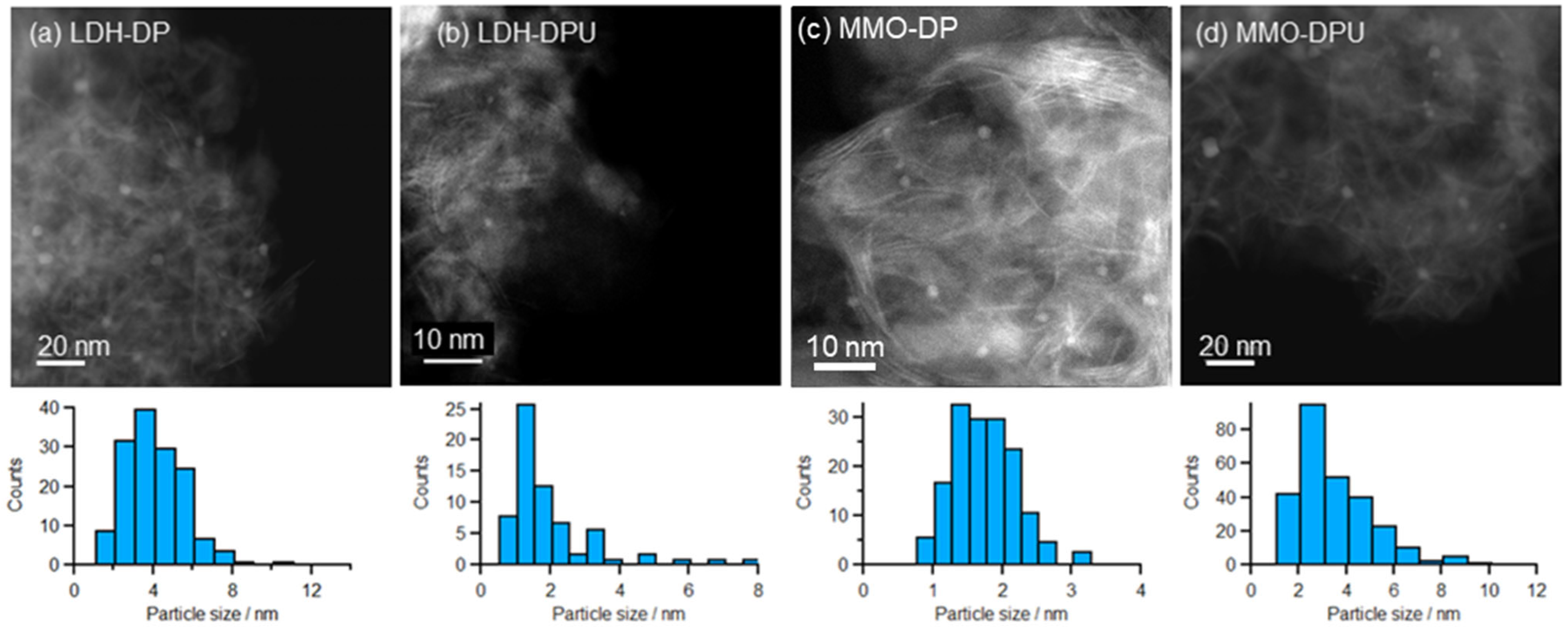
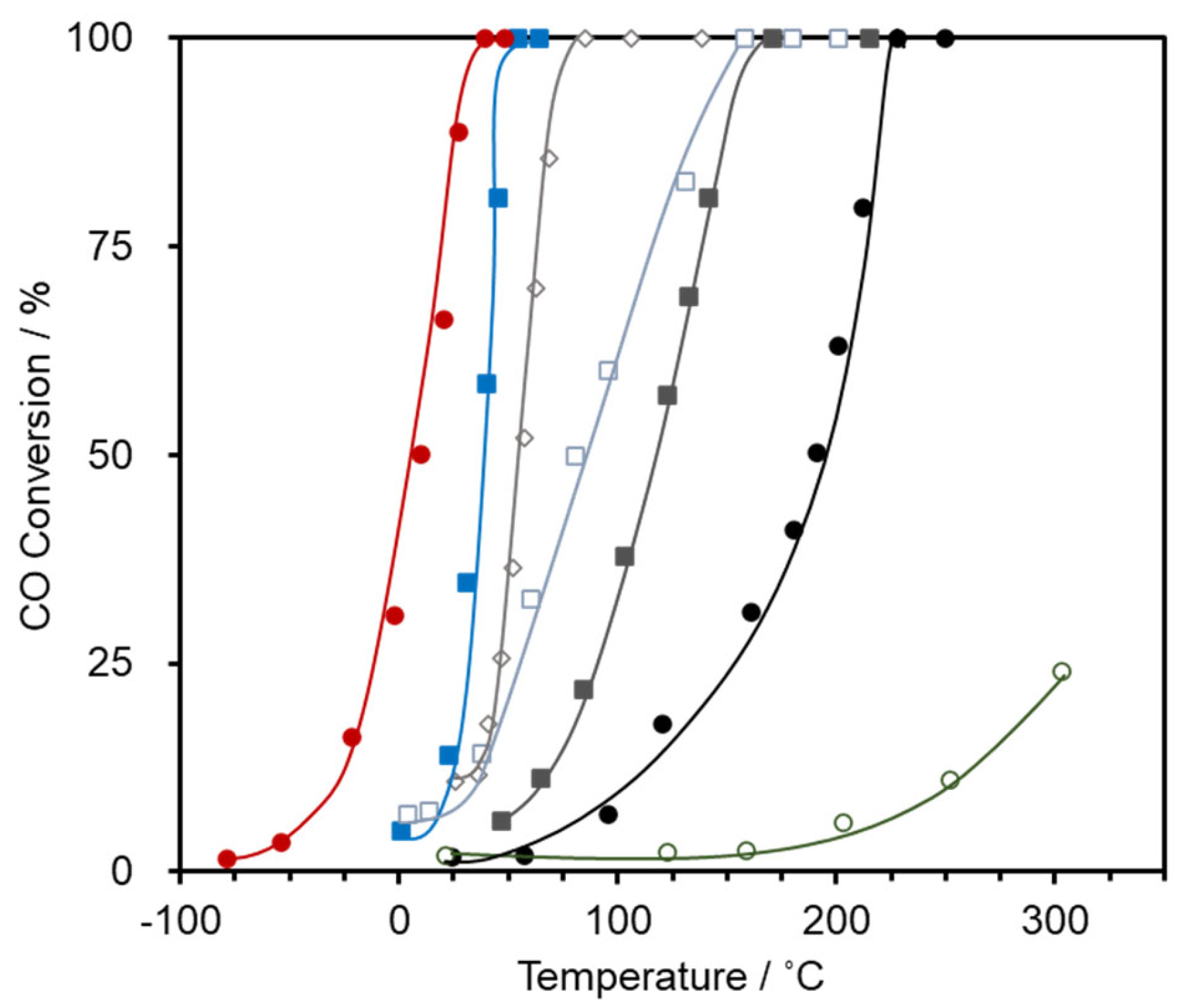
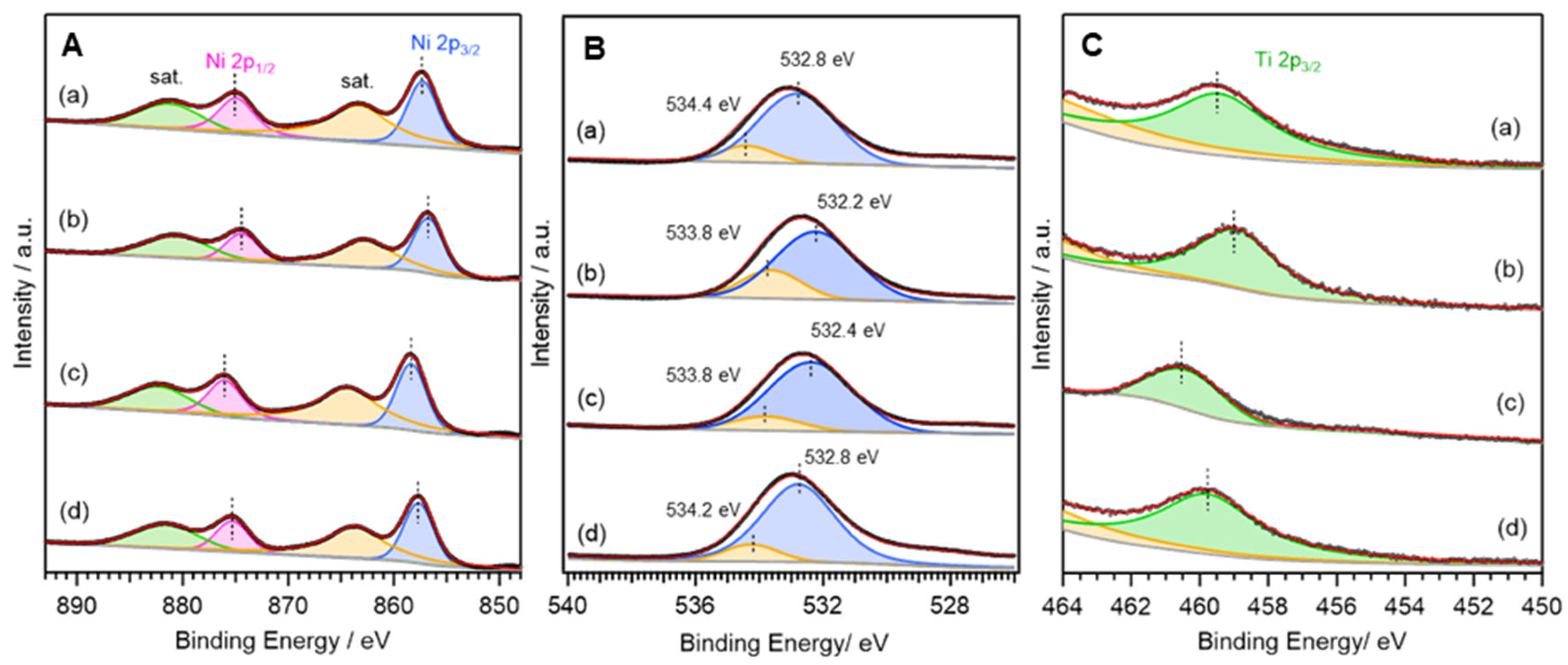

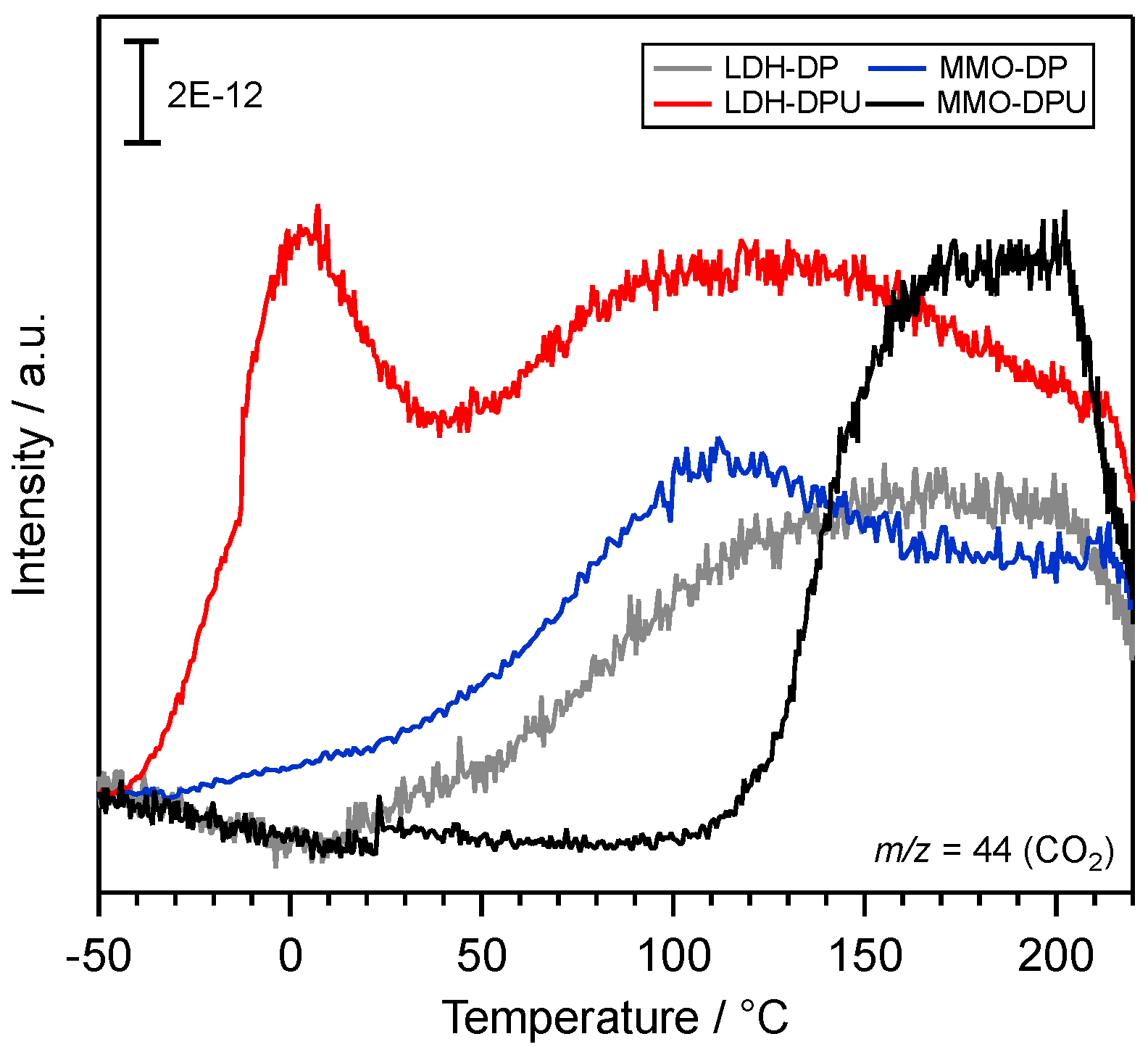
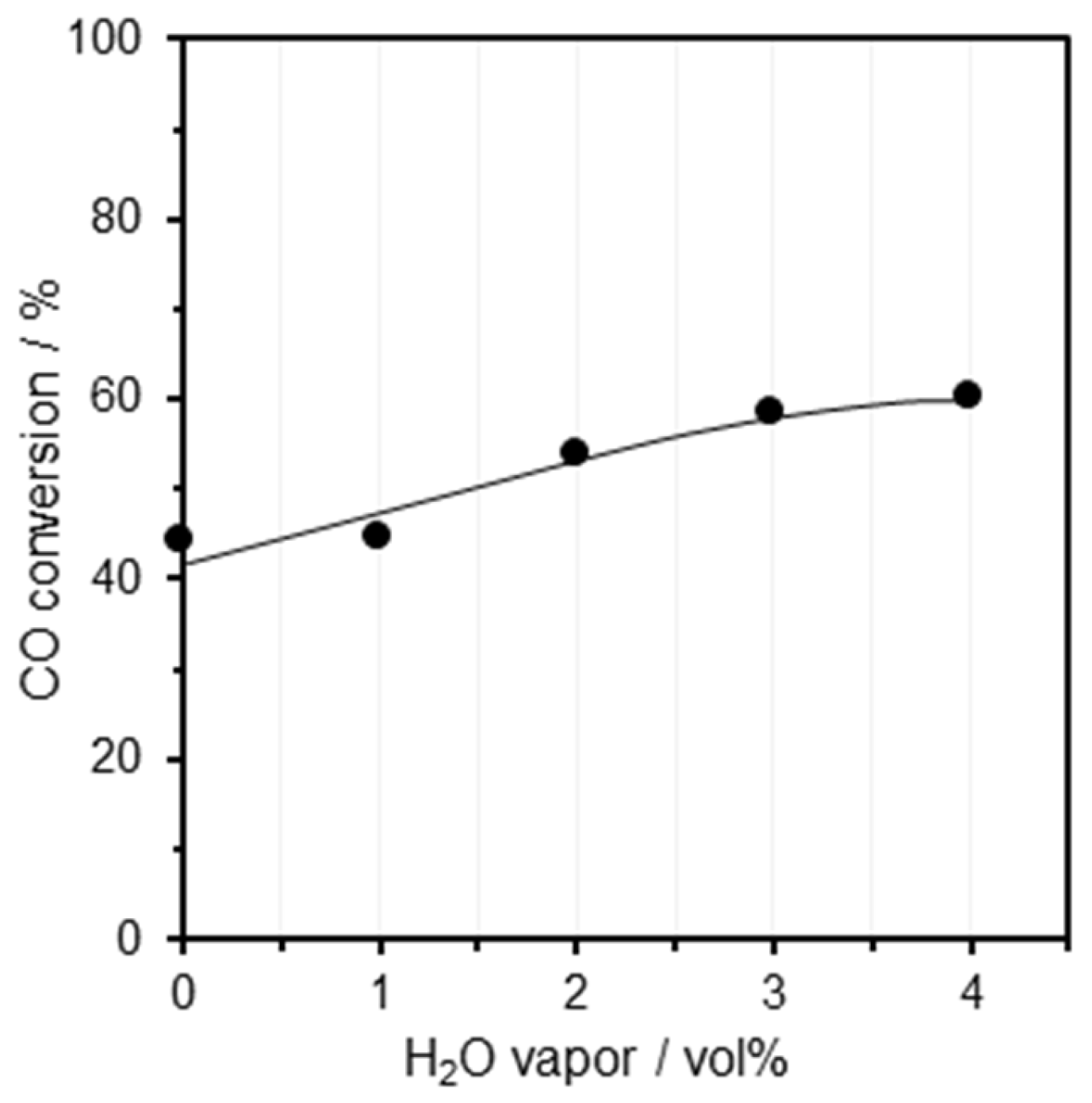
| Entry | Catalyst | Loading/wt% 1 | Au Size 2/nm | T1/23/°C | ||
|---|---|---|---|---|---|---|
| Au | Ni | Ti | ||||
| 1 | LDH-DP | 0.24 | 15 | 2.0 | 4.0 ± 1.5 | 115 |
| 2 | LDH-DPU | 0.28 | 15 | 2.6 | 2.3 ± 2.0 | 10 |
| 3 | MMO-DP | 0.15 | 15 | 2.9 | 1.7 ± 0.5 | 38 |
| 4 | MMO-DPU | 0.3 | 15 | 2.0 | 3.5 ± 1.8 | 191 |
| 5 | Au/Ni-Ti LDH/SiO2 | 0.28 | 15 | 2.6 | 3.5 ± 1.2 | 182 |
| 6 | LDH-DPU-300 | 0.28 | 15 | 2.6 | – | 87 |
| 7 | LDH-DPU-400 | 0.28 | 15 | 2.6 | – | 11 |
| 8 | Au/Ni-Ti MMO/SiO2 (Ni/Ti = 2/1) | 0.25 | 32 | 2.0 | 6.0 ± 2.1 4 | 65 |
| 9 | Au/bulk Ni-Ti MMO | 0.23 | – | – | 3.2 ± 1.3 | 24 |
| 10 | Au/TiO2 | 0.96 | – | – | 4.1 ± 2.2 | 10–20 |
| 11 | Au/NiO | 0.93 | – | – | – 5 | 57 |
| 12 | Au/SiO2 | 1.00 | – | – | 6.6 ± 2.7 | >300 |
| 13 | Au/Fe2O3 | 0.81 | – | – | 1.8 ± 0.7 | 36 |
Disclaimer/Publisher’s Note: The statements, opinions and data contained in all publications are solely those of the individual author(s) and contributor(s) and not of MDPI and/or the editor(s). MDPI and/or the editor(s) disclaim responsibility for any injury to people or property resulting from any ideas, methods, instructions or products referred to in the content. |
© 2023 by the authors. Licensee MDPI, Basel, Switzerland. This article is an open access article distributed under the terms and conditions of the Creative Commons Attribution (CC BY) license (https://creativecommons.org/licenses/by/4.0/).
Share and Cite
Takahashi, A.; Nakayama, A.; Murayama, T.; Sakaguchi, N.; Shimada, T.; Takagi, S.; Ishida, T. Au Clusters Supported on Defect-Rich Ni-Ti Oxides Derived from Ultrafine Layered Double Hydroxides (LDHs) for CO Oxidation at Ambient Temperature. Catalysts 2023, 13, 1155. https://doi.org/10.3390/catal13081155
Takahashi A, Nakayama A, Murayama T, Sakaguchi N, Shimada T, Takagi S, Ishida T. Au Clusters Supported on Defect-Rich Ni-Ti Oxides Derived from Ultrafine Layered Double Hydroxides (LDHs) for CO Oxidation at Ambient Temperature. Catalysts. 2023; 13(8):1155. https://doi.org/10.3390/catal13081155
Chicago/Turabian StyleTakahashi, Ayu, Akihiro Nakayama, Toru Murayama, Norihito Sakaguchi, Tetsuya Shimada, Shinsuke Takagi, and Tamao Ishida. 2023. "Au Clusters Supported on Defect-Rich Ni-Ti Oxides Derived from Ultrafine Layered Double Hydroxides (LDHs) for CO Oxidation at Ambient Temperature" Catalysts 13, no. 8: 1155. https://doi.org/10.3390/catal13081155
APA StyleTakahashi, A., Nakayama, A., Murayama, T., Sakaguchi, N., Shimada, T., Takagi, S., & Ishida, T. (2023). Au Clusters Supported on Defect-Rich Ni-Ti Oxides Derived from Ultrafine Layered Double Hydroxides (LDHs) for CO Oxidation at Ambient Temperature. Catalysts, 13(8), 1155. https://doi.org/10.3390/catal13081155







